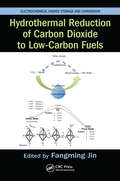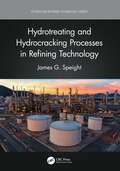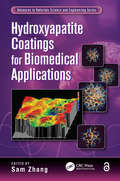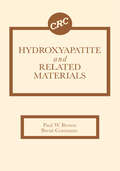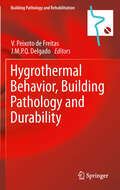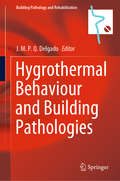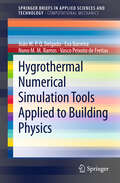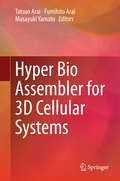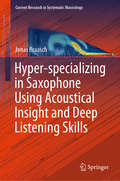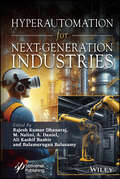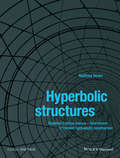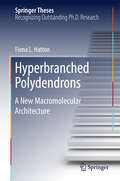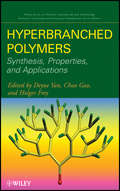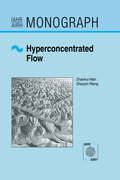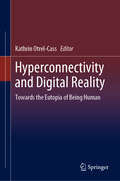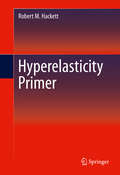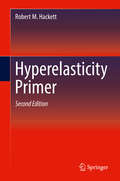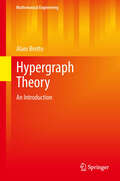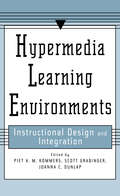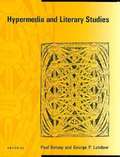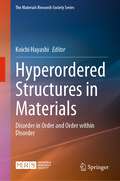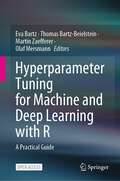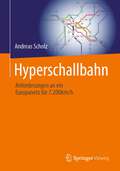- Table View
- List View
Hydrothermal Reduction of Carbon Dioxide to Low-Carbon Fuels (Electrochemical Energy Storage and Conversion)
by Fangming JinThe book covers advances in hydrothermal reduction of CO2 into low-carbon fuels. It offers perspectives from chemical engineering, environmental chemicals, organic chemistry, inorganic chemistry, physical chemistry, geology and materials science. It addresses fundamentals and applications of hydrothermal chemical processes, associated materials, and technologies. It describes reduction with biomass and dissociation of water by solar energy-driven two-step process. Challenges and strategies are discussed to facilitate research and development.
Hydrotreating and Hydrocracking Processes in Refining Technology (Petroleum Refining Technology Series)
by James G. SpeightWritten by an industry expert with over 50 years of experience, this book details the various solvent processes that are used in crude oil refineries. Providing an in-depth exploration of the different types of processes, as well as the types of feedstocks that can be used with them, this book prepares readers for changes as the industry evolves. Key Features: Describes feedstock evaluation and the effects of elemental, chemical, and fractional composition. Contains an extensive glossary of all related concepts in hydrotreating and hydrocracking processes. Considers next-generation processes and developments. This book is an essential guide for engineers, scientists, and students in the field of petroleum processing and refining technology, including professionals, technicians, management personnel, and academics.
Hydroxyapatite Coatings for Biomedical Applications (Advances In Materials Science And Engineering Ser.)
by Sam ZhangHydroxyapatite coatings are of great importance in the biological and biomedical coatings fields, especially in the current era of nanotechnology and bioapplications. With a bonelike structure that promotes osseointegration, hydroxyapatite coating can be applied to otherwise bioinactive implants to make their surface bioactive, thus achieving faster healing and recovery. In addition to applications in orthopedic and dental implants, this coating can also be used in drug delivery. Hydroxyapatite Coatings for Biomedical Applications explores developments in the processing and property characterization and applications of hydroxyapatite to provide timely information for active researchers and newcomers alike. In eight carefully reviewed chapters, hydroxyapatite experts from the United States, Japan, Singapore, and China present the latest on topics ranging from deposition processes to biomedical applications in implants and drug delivery. This book discusses: Magnetron sputtering and electrochemical deposition The modification of hydroxyapatite properties by sol–gel deposition to incorporate other elements found in natural bones, such as zinc, magnesium, and fluorine The use of pure hydroxyapatite in drug delivery applications The growth or self-assembly of hydroxyapatite on shape memory alloy Hydroxyapatite composite coatings—with carbon nanotubes, titanium dioxide (TiO2), and others—on the titanium alloy Offering valuable insights and a wealth of data, including numerous tables and figures, this is a rich source of information for research on hydroxyapatite coatings. Each chapter also covers material that provides an accessible stepping stone for those who are new to the field.
Hydroxyapatite and Related Materials
by Paul W. Brown Brent ConstantzAudienceApplied biomathematicians, orthopedists, clinical orthopedists.
Hygienegerechte Apparate und Anlagen: In der Lebensmittel-, Pharma- und Kosmetikindustrie
by Gerhard HauserIn der Lebensmittel-, der kosmetischen, pharmazeutischen und chemischen Industrie sowie in der Biotechnologie ist zum Schutz vor Kontamination ein hygienischer Produktionsprozess sehr wichtig. Sichere Qualitatsprodukte lassen sich nur mit Anlagen herstellen, die sich zuverlassig reinigen lassen. Deshalb spielt bei der Herstellung hochreiner Produkte "Hygienic Design" moderner Anlagen, Apparate, Komponenten und Prozessraume eine entscheidende Rolle. In allen Industriezweigen konnen dadurch erhebliche Kosten fur den Reinigungsaufwand und zur Reduzierung der Umweltbelastung eingespart werden. Das vorliegende Werk baut auf dem Buch Hygienische Produktionstechnologie auf und beschreibt die Komponenten und Bauteile, die fur die Konstruktion hygienegerechter Apparate und Anlagen benotigt werden. Es richtet sich besonders an Ingenieure im konstruktiven Bereich in der Lebensmittel-, Pharma- und Kosmetikindustrie, aber auch an Betriebsangehorige, die fur Qualitat, Risikoanalysen und Produktsicherheit bei der Produktherstellung verantwortlich sind.
Hygrothermal Behavior, Building Pathology and Durability
by Vasco Peixoto Freitas J.M.P.Q. DelgadoThe main purpose of this book, Hygrothermal, Building Pathology and Durability, is to provide a collection of recent research works to contribute to the systematization and dissemination of knowledge related to construction pathology, hygrothermal behaviour of buildings, durability and diagnostic techniques and, simultaneously, to show the most recent advances in this domain. It includes a set of new developments in the field of building physics and hygrothermal behaviour, durability approach for historical and old buildings and building pathology vs. durability. The book is divided in several chapters that are a resume of the current state of knowledge for benefit of professional colleagues, scientists, students, practitioners, lecturers and other interested parties to network.
Hygrothermal Behaviour and Building Pathologies (Building Pathology and Rehabilitation #14)
by J. M. P. Q. DelgadoThis book presents recent research in the area of construction pathology, hygrothermal behaviour of buildings, service life and diagnostic techniques, and highlights the latest developments in building physics, hygrothermal behaviour, durability and numerical models applied to building materials analysis. Discussing the state of the art in the field, and covering topics relevant to variety of engineering disciplines, such as civil, materials and mechanical engineering, it will appeal to scientists, students, practitioners, lecturers and other stakeholders.
Hygrothermal Numerical Simulation Tools Applied to Building Physics
by Vasco Peixoto Freitas Eva Barreira Nuno M.M. Ramos João M.P.Q. DelgadoThis book presents a critical review on the development and application of hygrothermal analysis methods to simulate the coupled transport processes of Heat, Air, and Moisture (HAM) transfer for one or multidimensional cases. During the past few decades there has been relevant development in this field of study and an increase in the professional use of tools that simulate some of the physical phenomena that are involved in Heat, Air and Moisture conditions in building components or elements. Although there is a significant amount of hygrothermal models referred in the literature, the vast majority of them are not easily available to the public outside the institutions where they were developed, which restricts the analysis of this book to only 14 hygrothermal modelling tools. The special features of this book are (a) a state-of-the-art of numerical simulation tools applied to building physics, (b) the boundary conditions importance, (c) the material properties, namely, experimental methods for the measurement of relevant transport properties, and (d) the numerical investigation and application The main benefit of the book is that it discusses all the topics related to numerical simulation tools in building components (including state-of-the-art and applications) and presents some of the most important theoretical and numerical developments in building physics, providing a self-contained major reference that is appealing to both the scientists and the engineers. At the same time, this book will be going to the encounter of a variety of scientific and engineering disciplines, such as civil and mechanical engineering, architecture, etc... The book is divided in several chapters that intend to be a resume of the current state of knowledge for benefit of professional colleagues.
Hypatia von Alexandria
by Laurel A. RockefellerAls die westliche Welt in Dunkelheit versank, wagte sie, das Licht zu verteidigen. Geboren im Jahr 355 der christlichen Zeitrechnung, im Nachhall von Konstantins Regierung, lebte Hypatia von Alexandria in einem zusammenbrechenden Römischen Reich. In einer Welt, in der der Gehorsam gegen religiöse Autoritäten über die Wissenschaft triumphierte, in der Logik und Verstand die neue Weltordnung bedrohten. Es war eine Welt an der Grenze zum düsteren Mittelalter, eine Welt, die über die Fragen Wissenschaft gegen Religion, Freiheit gegen Strenggläubigkeit, Toleranz gegen Hass entschied. Über vierzig Jahre stand Hypatia zwischen dem dunklen Zeitalter und dem Licht der Philosophie, Künste und Wissenschaft. Auch wenn keines ihrer Werke die offensive Bücherverbrennung religiöser Fanatiker überdauert hat, so bleibt doch ihr Vermächtnis als eine der größten Gelehrten aller Zeiten. Dies ist ihre faszinierende und wahre Geschichte. Das Buch beinhaltet außerdem eine Bibliografie, eine detaillierte Zeitleiste und die Längen- und Breitengrade ausgewählter Städte des Römischen Reiches, sodass Sie die Wunder des Himmels gemeinsam mit Hypatia erkunden können.
Hyper Bio Assembler for 3D Cellular Systems
by Tatsuo Arai Fumihito Arai Masayuki YamatoHyper Bio Assembler for Cellular Systems is the first book to present a new methodology for measuring and separating target cells at high speed and constructing 3D cellular systems in vitro. This book represents a valuable resource for biologists, biophysicists and robotic engineers, as well as researchers interested in this new frontier area, offering a better understanding of the measurement, separation, assembly, analysis and synthesis of complex biological tissue, and of the medical applications of these technologies. This book is the outcome of the new academic fields of the Ministry of Education, Culture, Sports, Science and Technology's Grant-in-Aid for Scientific Research in Japan.
Hyper-specializing in Saxophone Using Acoustical Insight and Deep Listening Skills (Current Research in Systematic Musicology #6)
by Jonas BraaschThis book presents a novel method of grafting musical wind instruments by exchanging an instrument’s standard mouthpiece with different tone generators. Using the concrete example of the soprano saxophone, it describes how, with six other tone generators, including brass, double reed, and free reed mechanisms, the saxophone can be extended to nearly every wind instrument category in the von Hornbostel and Sachs classification system. The book demonstrates how it is possible to play these instrument variations with high proficiency, and describes the method of hyper-specialization, including acoustical insights, conservatory training methods and the underlying philosophy. The latter is based on the cultural traditions of the different wind instrument prototypes and the Deep Listening philosophy of cultivating internal diversity, and approach that leads to a new level of wind instrument virtuosity that offers great timbral variety combined with the flexibility of a regular acoustic wind instrument.
Hyperautomation for Next-Generation Industries
by Balamurugan Balusamy Ali Kashif Bashir Rajesh Kumar Dhanaraj M. Nalini A. DanielThis book is essential for anyone looking to understand how hyperautomation can revolutionize businesses by simplifying operations, reducing errors, and creating more intelligent and adaptable workplaces through the use of automation technologies such as artificial intelligence, machine learning, and robotic process automation. The use of automation technologies to simplify any and every activity conceivable in a business, allowing repeated operations to operate without manual intervention, is known as hyperautomation. Hyperautomation transforms current and old processes and equipment by utilizing artificial intelligence, machine learning, and robotic process automation. This digital transformation may assist a business in gaining cost and resource efficiency, allowing it to prosper in a more competitive environment. With the advancement of automation technologies, hyperautomation is becoming more prevalent. Companies are shifting their methods to create more human-centered and intelligent workplaces. This change has ushered in a new era for organizations that rely on technology and automation tools to stay competitive. Businesses may move beyond technology’s distinct advantages to genuine digital agility and scale adaptability when all forms of automation operate together in close partnership. Automation tools must be simple to incorporate into the current technological stack while not requiring too much effort from IT. A platform must be able to plug and play with a wide range of technologies to achieve hyperautomation. The interdependence of automation technologies is a property that is connected to hyperautomation. Hyperautomation saves individuals time and money by reducing errors. Hyperautomation has the potential to create a workplace that is intelligent, adaptable, and capable of making quick, accurate decisions based on data and insights. Model recognition is used to determine what to do next and to optimize processes with the least amount of human engagement possible.
Hyperbolic Structures: Shukhov's Lattice Towers - Forerunners of Modern Lightweight Construction
by Matthias BeckhHyperbolic structures analyses the interactions of form with the structural behaviour of hyperbolic lattice towers, and the effects of the various influencing factors were determined with the help of parametric studies and load capacity analyses. This evaluation of Shukhov’s historical calculations and the reconstruction of the design and development process of his water towers shows why the Russian engineer is considered not only a pathfinder for lightweight structures but also a pioneer of parametrised design processes.
Hyperbranched Polydendrons
by Fiona L. HattonThis thesis outlines the first synthesis of a new complex branched polymer architecture that aims to combine the benefits of dendrimers with the simplicity of conventional polymerisation. There is no other available literature on these remarkable materials, dubbed hyperbranched polydendrons, due to their novelty. The new materials were shown to have very high molecular weights (>1,000,000 g/mol), exceptional self-assembly and encapsulation behaviour and unparalleled functionalisation capabilities, and were studied pharmacologically to determine their potential as oral nanomedicine candidates. The detailed investigation of the chemical variables involved in synthesising hyperbranched polydendrons has shown that their self-assembly and pharmacological behaviour can be turned on and off and fine-tuned by altering the composition of the materials. The permeation of the self-assembled particles through model gut epithelium suggests the potential for oral dosing of drug loaded nanomedicines that result in circulating nanoparticles - a research goal that is currently being pursued by several groups around the globe.
Hyperbranched Polymers
by Deyue Yan Chao Gao Holger FreyA much-needed overview of the state of the art of hyperbranched polymersThe last two decades have seen a surge of interest in hyperbranched polymers due to their ease of synthesis on a large scale and their promising applications in diverse fields, from medicine to nanotechnology.Written by leading scientists in academia and industry, this book provides for the first time a comprehensive overview of the topic, bringing together in one complete volume a wealth of information previously available only in articles scattered across the literature. Drawing on their work at the cutting edge of this dynamic area of research, the authors cover everything readers need to know about hyperbranched polymers when designing highly functional materials. Clear, thorough discussions include:How irregular branching affects polymer properties and their potential applicationsImportant theoretical basics, plus a useful summary of characterization techniquesHow hyperbranched polymers compare with dendrimers as well as linear polymersFuture trends in the synthesis and application of hyperbranched polymersGeared to novices and experts alike, Hyperbranched Polymers is a must-have resource for anyone working in polymer architectures, polymer engineering, and functional materials. It is also useful for scientists in related fields who need a primer on the synthesis, theory, and applications of hyperbranched polymers.
Hyperconcentrated Flow (Iahr Monographs)
by Zhaoyin Wang Zhaohui WanConsiders hyperconcentrated flow, a phenomenon peculiar to the Yellow River Basin. The feasibility of using the potential for sediment carrying by hyperconcentrated flow can also be applied to topics such as hypertransport, debris flow and sediment releases from reservoirs.
Hyperconnectivity and Digital Reality: Towards the Eutopia of Being Human
by Kathrin Otrel-CassThis book addresses the topic of hyperconnectivity by building on, expanding, and critically examining issues that have to do with information communication technology (ICT) and networked societies. The book explores questions relating to attention and consciousness, techno-capitalism and communicative action taking. Adopting different philosophical angles to assess the challenges we face due to our entanglement with hyperconnected technologies, the book studies performance and performativity in a digitised world by considering the unfolding of our onlife and by looking at what this means to educated future scientists and engineers in a hyperconnected world. The book further discusses digital activities as the new constructs of ourselves and poses questions about how much literacy is needed for us not to be enslaved by those constructs. The book also explores the challenges of hyperconnectivity and the health sector to showcase the vulnerabilities we are increasingly exposed to. It makes clear that - since the boundaries between on- and offline are becoming increasingly blurred - we will require new, flexible frameworks that reconsider what it means to be human in a hyperconnected world.
Hyperelasticity Primer
by Robert M. HackettThis book introduces the subject of hyperelasticity in a concise manner mainly directed to students of solid mechanics who have a familiarity with continuum mechanics. It focuses on important introductory topics in the field of nonlinear material behavior and presents a number of example problems and solutions to greatly aid the student in mastering the difficulty of the subject and gaining necessary insight. Professor Hackett delineates the concepts and applications of hyperelasticity in such a way that a new student of the subject can absorb the intricate details without having to wade through excessively complicated formulations. The book further presents significant review material on intricately related subjects such as tensor calculus and introduces some new formulations.
Hyperelasticity Primer
by Robert M. HackettThis book introduces the subject of hyperelasticity in a concise manner mainly directed to students of solid mechanics who have a familiarity with continuum mechanics. It focuses on important introductory topics in the field of nonlinear material behavior and presents a number of example problems and solutions to greatly aid the student in mastering the difficulty of the subject and gaining necessary insight. Professor Hackett delineates the concepts and applications of hyperelasticity in such a way that a new student of the subject can absorb the intricate details without having to wade through excessively complicated formulations. The book further presents significant review material on intricately related subjects such as tensor calculus and introduces some new formulations.
Hypergraph Theory
by Alain BrettoThis book provides an introduction to hypergraphs, its aim being to overcome the lack of recent manuscripts on this theory. In the literature hypergraphs have many other names such as set systems and families of sets. This work presents the theory of hypergraphs in its most original aspects, while also introducing and assessing the latest concepts on hypergraphs. The variety of topics, their originality and novelty are intended to help readers better understand the hypergraphs in all their diversity in order to perceive their value and power as mathematical tools. This book will be a great asset to upper-level undergraduate and graduate students in computer science and mathematics. It has been the subject of an annual Master's course for many years, making it also ideally suited to Master's students in computer science, mathematics, bioinformatics, engineering, chemistry, and many other fields. It will also benefit scientists, engineers and anyone else who wants to understand hypergraphs theory.
Hypermedia Learning Environments: Instructional Design and Integration
by Piet A. M. Kommers Scott Grabinger Joanna C. DunlapHypermedia and multimedia have penetrated the world of computer games, Internet, and CD-ROM based reference manuals. However, the fields of education, schooling, and training ask more specific benefits from them. This book provides practical approaches to transform these media into learning tools. Crucial helping steps include the migration from expository to exploratory learning strategies, the integration of collaborative learning practices in plenary and individualistic teaching styles, and the evolution from test-driven to experience-oriented training. This volume has three goals: * to discuss the concepts of hypermedia, multimedia, and hypertext and review pertinent research lines; * to provide guidelines and suggestions for developing multimedia applications; and * to place technology within a broader context of education and training through a discussion of rich environments for active learning (REALs). The book takes a developmental focus to helpf readers set up and manage the process of developing a multimedia application. It is not a technical or a how-to manual on working with video, sound, digitized graphics, or computer code. The text takes a unique approach to the idea of media-- viewing media as delivery systems: if video is called for, use it; if sound will help in an application, use it. The fundamental guidelines presented here are usually not media specific. Media works only within the strategies with which they are used. Aimed at practitioners--people who teach about or develop multimedia and hypermedia applications--this volume carefully examines the main components and issues in developing applications. It provides suggestions and heuristics for sound, fundamental design processes.
Hypermedia and Literary Studies
by Paul Delany George P. LandowThe essays in Hypermedia and Literary Studies discuss the theoretical and practical opportunities and challenges posed by the convergence of hypermedia systems and traditional written texts.
Hyperordered Structures in Materials: Disorder in Order and Order within Disorder (The Materials Research Society Series)
by Koichi HayashiThis book introduces characterizations of hyperordered structures using latest quantum beam technologies, the advanced theoretical methods for understanding the roles of the structures, and the state-of-the-arts materials containing the structures. In this book, the authors focus on the importance of defect complexes to improve functionality of crystals and that of orders of network structures to improve functionality of glass materials. These features can be regarded as interphases between perfect crystals and perfect amorphous, and they are the key factor for the evolution of materials science to a new dimension. The authors call such interphases "hyperordered structures" in this book. This is the first book that comprehensively summarizes glass science, defect science, and quantum beam science. It is valuable not only for active researchers in industry and academia but also graduate students.
Hyperparameter Tuning for Machine and Deep Learning with R: A Practical Guide
by Thomas Bartz-Beielstein Eva Bartz Martin Zaefferer Olaf MersmannThis open access book provides a wealth of hands-on examples that illustrate how hyperparameter tuning can be applied in practice and gives deep insights into the working mechanisms of machine learning (ML) and deep learning (DL) methods. The aim of the book is to equip readers with the ability to achieve better results with significantly less time, costs, effort and resources using the methods described here. The case studies presented in this book can be run on a regular desktop or notebook computer. No high-performance computing facilities are required. The idea for the book originated in a study conducted by Bartz & Bartz GmbH for the Federal Statistical Office of Germany (Destatis). Building on that study, the book is addressed to practitioners in industry as well as researchers, teachers and students in academia. The content focuses on the hyperparameter tuning of ML and DL algorithms, and is divided into two main parts: theory (Part I) and application (Part II). Essential topics covered include: a survey of important model parameters; four parameter tuning studies and one extensive global parameter tuning study; statistical analysis of the performance of ML and DL methods based on severity; and a new, consensus-ranking-based way to aggregate and analyze results from multiple algorithms. The book presents analyses of more than 30 hyperparameters from six relevant ML and DL methods, and provides source code so that users can reproduce the results. Accordingly, it serves as a handbook and textbook alike.
Hyperschallbahn: Anforderungen an ein Europanetz für 7.200km/h
by Andreas ScholzDas Buch beschreibt die Anforderungen an ein Europanetz der Hyperschallbahn auf der Basis der Vakuum-Magnetbahn-Technologie. Es veranschaulicht die vorhandenen und perspektivischen Marktpotenziale im kontinentalen und interkontinentalen Verkehr unter der Maßgabe, dass der Luftverkehr weitgehend durch das neue Verkehrssystem abgelöst wird. Das Buch leitet die Anforderungen an die wesentlichen Systemelemente und die Netzgestaltung ab, um die Marktpotenziale vollständig zu erschließen. Es beschreibt ein Basisnetz und ermittelt auf dieser Grundlage die Entwicklung der Erträge und Kosten sowie die Finanzierung des Systems in einer definierten Zeitlinie über einen gesamten Lebenszyklus. Ergänzend werden weitere breitgefächerte Nachfrage-Szenarien aufgezeigt und technisch-betriebswirtschaftlich bewertet. Das Buch beschreibt die Auswirkungen des Vakuum-Magnetbahn-Systems auf den Luftverkehr und zeigt abschließend Handlungsfelder für die Realisierung des neuen Verkehrssystems auf.
